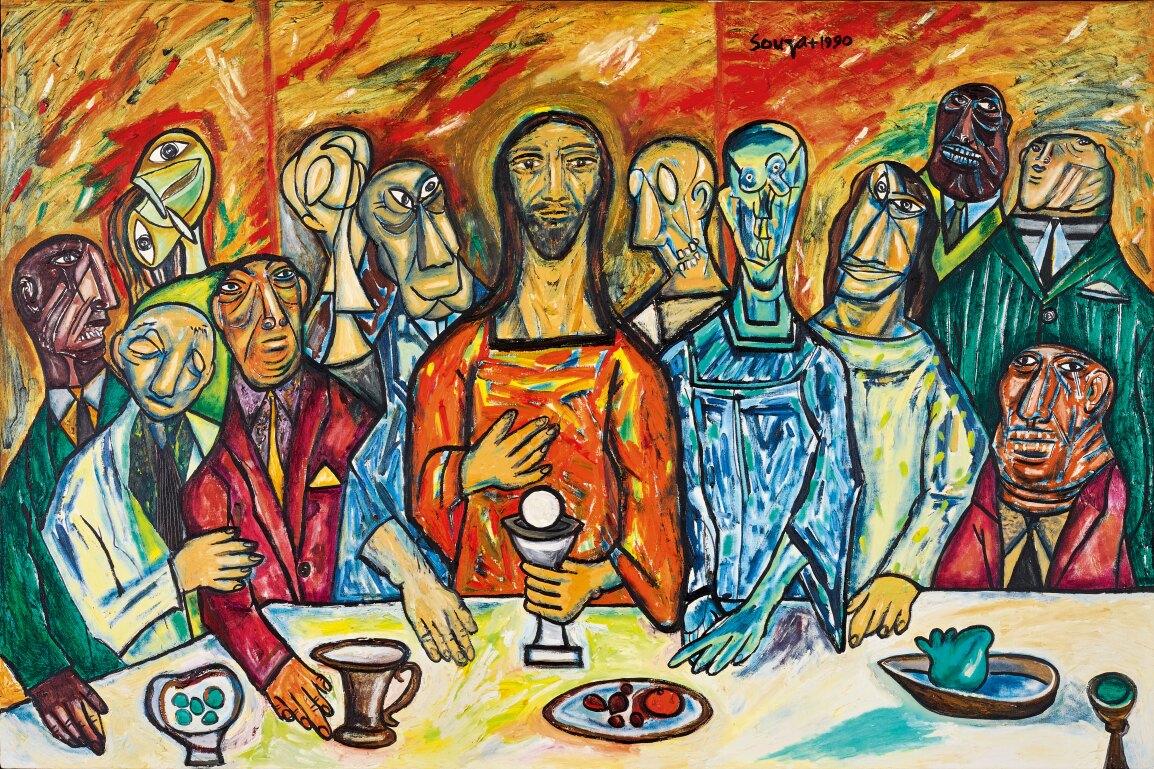N otable Indian and Western critics who have followed Souza’s almost seven-decade-long career, attach great significance to the artist’s upbringing and formative years in Catholic Goa. As a child, he suffered from a serious attack of smallpox and his mother vowed that if he ever survived she would enroll her son in the Jesuit priesthood. He was cured but never became a priest, and his mother’s vow seems to have imparted a dark sense of responsibility on the young boy’s consciousness. The artist describes the “dream world” that was born: “the phantasmagorias, the hallucinations, angels in paradise… vividly imagined”. This dream world persists through Souza’s life’s work in his countless paintings that depict religious subjects through a monstrous aesthetic. These works, the current painting included, communicate the artist's complex attitude to a religion that fascinated and revolted him in equal measure.
Da Vinci’s mural, in accordance with the Gospel of John, 13:21, represents the Passover meal which Jesus shared with his disciples in Jerusalem before his crucifixion. More specifically, Da Vinci illustrates the moment when Christ reveals to his followers that he is to be betrayed by one of them. With dismayed faces and gestural hands, the twelve men exclaim to their teacher and converse amongst themselves. In Souza’s 1990 reinterpretation, this consternation is expressed through the Apostle’s contorted and disfigured faces. The sorrowful, downwards gaze of John who sits to Jesus’s left in Da Vinci’s masterwork, is echoed in the white-jacketed figure on the left of Souza’s canvas. Christ in the fifteenth-century imagining exhibits a similar downcast expression, whereas Souza’s protagonist stares forthright out at the viewer.
Souza has depicted the aftermath of the Last Supper in some of his most celebrated masterpieces, such as in Crucifixion (1959) – where Christ is represented in agonizing pain upon the cross – and in Deposition (1963) – where Christ’s crucified, bleeding body is moved for burial. Moreover, the Last Supper formed the origin of the Catholic tradition of the Eucharist, a subject Souza frequently illustrated in his still-life paintings of the mid-1950s to early 1960s, which show an array of liturgical objects set upon a table. Painting the scene of the Last Supper decades later, Souza is signaling the pivotal importance of this event both for Catholicism and his own artistic production.
"… [Francis Newton] Souza may best be remembered for his compelling paintings of Christ and the power of his erotically charged nudes. These were his subjects and the imagery of his most important works. Here the east, the west, the spiritual and the physical fuse together, giving credence to his often used declaration that, the “whole meaning of life is life itself!"
Besides the subject of the current painting, the means of figuration may also be traced back to Souza’s early works. The faces of Jesus’s Apostles, with their high-set eyes, lopsided features and harsh outlines, are evocative of the artist’s stylised heads from the late 1950s and 60s. Art critic Edwin Mullins described Souza’s works from this early period as being ‘distorted to the point of destruction’. This late painting exhibits the same malformation, depicting, to borrow Mullins’ words, ‘grotesque faces with eyes anywhere’. This is true, however, mostly of the disciples; Jesus does not evince the same facial distortion, except for his elongated neck and enlarged features. Souza thus furnishes Christ with a dignity not as clear in his previous monstrous and subversive depictions.
Souza was among the first Indian modernists to be recognised on an international level, and he has continued to be one of the most celebrated artists of South Asian origin in Western institutions. Since the final phase in his artistic production, Souza has been exhibited at numerous eminent galleries and museums across the world. In 2005, he was honoured with a major retrospective at Tate Britain, Religion and Erotica, and further celebrated by Tate Modern with the re-hanging of his iconic 1959 Crucifixion, which the gallery had acquired a decade previously in 1993. Last year, Tate Britain dedicated an entire room to Souza in their landmark figural exhibition, All Too Human, and New York’s Asia Society included a large number of his works at their milestone retrospective of Indian modern art. The present work comes from the collection of the Glenbarra Museum of Art in Japan and is a magnificent and lasting testament to Souza’s complex psychology and artistic genius.





